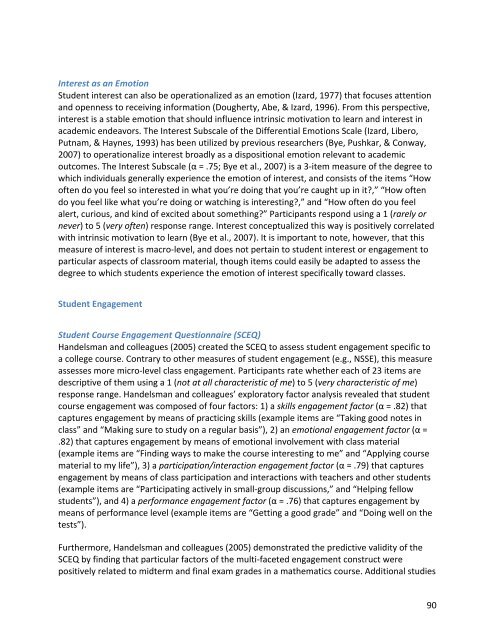A COMPENDIUM OF SCALES for use in the SCHOLARSHIP OF TEACHING AND LEARNING
compscalesstl
compscalesstl
You also want an ePaper? Increase the reach of your titles
YUMPU automatically turns print PDFs into web optimized ePapers that Google loves.
Interest as an Emotion<br />
Student <strong>in</strong>terest can also be operationalized as an emotion (Izard, 1977) that foc<strong>use</strong>s attention<br />
and openness to receiv<strong>in</strong>g <strong>in</strong><strong>for</strong>mation (Dougherty, Abe, & Izard, 1996). From this perspective,<br />
<strong>in</strong>terest is a stable emotion that should <strong>in</strong>fluence <strong>in</strong>tr<strong>in</strong>sic motivation to learn and <strong>in</strong>terest <strong>in</strong><br />
academic endeavors. The Interest Subscale of <strong>the</strong> Differential Emotions Scale (Izard, Libero,<br />
Putnam, & Haynes, 1993) has been utilized by previous researchers (Bye, Pushkar, & Conway,<br />
2007) to operationalize <strong>in</strong>terest broadly as a dispositional emotion relevant to academic<br />
outcomes. The Interest Subscale (α = .75; Bye et al., 2007) is a 3-item measure of <strong>the</strong> degree to<br />
which <strong>in</strong>dividuals generally experience <strong>the</strong> emotion of <strong>in</strong>terest, and consists of <strong>the</strong> items “How<br />
often do you feel so <strong>in</strong>terested <strong>in</strong> what you’re do<strong>in</strong>g that you’re caught up <strong>in</strong> it?,” “How often<br />
do you feel like what you’re do<strong>in</strong>g or watch<strong>in</strong>g is <strong>in</strong>terest<strong>in</strong>g?,” and “How often do you feel<br />
alert, curious, and k<strong>in</strong>d of excited about someth<strong>in</strong>g?” Participants respond us<strong>in</strong>g a 1 (rarely or<br />
never) to 5 (very often) response range. Interest conceptualized this way is positively correlated<br />
with <strong>in</strong>tr<strong>in</strong>sic motivation to learn (Bye et al., 2007). It is important to note, however, that this<br />
measure of <strong>in</strong>terest is macro-level, and does not perta<strong>in</strong> to student <strong>in</strong>terest or engagement to<br />
particular aspects of classroom material, though items could easily be adapted to assess <strong>the</strong><br />
degree to which students experience <strong>the</strong> emotion of <strong>in</strong>terest specifically toward classes.<br />
Student Engagement<br />
Student Course Engagement Questionnaire (SCEQ)<br />
Handelsman and colleagues (2005) created <strong>the</strong> SCEQ to assess student engagement specific to<br />
a college course. Contrary to o<strong>the</strong>r measures of student engagement (e.g., NSSE), this measure<br />
assesses more micro-level class engagement. Participants rate whe<strong>the</strong>r each of 23 items are<br />
descriptive of <strong>the</strong>m us<strong>in</strong>g a 1 (not at all characteristic of me) to 5 (very characteristic of me)<br />
response range. Handelsman and colleagues’ exploratory factor analysis revealed that student<br />
course engagement was composed of four factors: 1) a skills engagement factor (α = .82) that<br />
captures engagement by means of practic<strong>in</strong>g skills (example items are “Tak<strong>in</strong>g good notes <strong>in</strong><br />
class” and “Mak<strong>in</strong>g sure to study on a regular basis”), 2) an emotional engagement factor (α =<br />
.82) that captures engagement by means of emotional <strong>in</strong>volvement with class material<br />
(example items are “F<strong>in</strong>d<strong>in</strong>g ways to make <strong>the</strong> course <strong>in</strong>terest<strong>in</strong>g to me” and “Apply<strong>in</strong>g course<br />
material to my life”), 3) a participation/<strong>in</strong>teraction engagement factor (α = .79) that captures<br />
engagement by means of class participation and <strong>in</strong>teractions with teachers and o<strong>the</strong>r students<br />
(example items are “Participat<strong>in</strong>g actively <strong>in</strong> small-group discussions,” and “Help<strong>in</strong>g fellow<br />
students”), and 4) a per<strong>for</strong>mance engagement factor (α = .76) that captures engagement by<br />
means of per<strong>for</strong>mance level (example items are “Gett<strong>in</strong>g a good grade” and “Do<strong>in</strong>g well on <strong>the</strong><br />
tests”).<br />
Fur<strong>the</strong>rmore, Handelsman and colleagues (2005) demonstrated <strong>the</strong> predictive validity of <strong>the</strong><br />
SCEQ by f<strong>in</strong>d<strong>in</strong>g that particular factors of <strong>the</strong> multi-faceted engagement construct were<br />
positively related to midterm and f<strong>in</strong>al exam grades <strong>in</strong> a ma<strong>the</strong>matics course. Additional studies<br />
90


